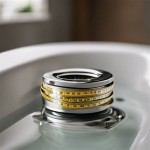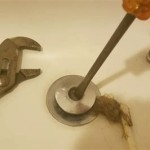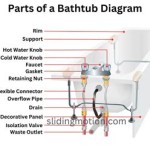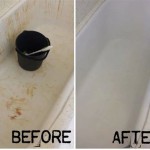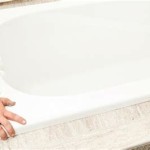Bathtub Overflow Plate Cover: Function, Selection, and Maintenance
The bathtub overflow plate cover, often overlooked, serves a critical function in a bathroom's plumbing system. It is more than just a decorative element; this component is crucial for preventing water damage by directing excess water down the drain when the bathtub reaches a certain level. Understanding its purpose, the different types available, and how to properly maintain it is essential for homeowners to ensure the long-term functionality of their bathtubs.
The primary role of the bathtub overflow plate cover is to prevent flooding. Bathtubs are designed with an overflow drain, typically located a few inches below the rim. This drain is connected to the main drainpipe, providing an escape route for water when the tub is filled beyond its intended capacity. The overflow plate cover conceals this drain and provides a mechanism, usually a lever or a knob, to open and close the internal drain stopper located at the bottom of the bathtub. Without a properly functioning overflow plate cover, the overflow drain could become clogged or damaged, leading to potential water damage to the surrounding walls and floors.
Furthermore, the overflow plate cover contributes to the overall aesthetic of the bathroom. It is often designed to complement the other fixtures and hardware, such as the faucet, showerhead, and drain stopper. Manufacturers offer a wide variety of styles, finishes, and materials to match different bathroom decors, allowing homeowners to choose a cover that seamlessly integrates with their existing design scheme.
Understanding the Functionality of the Bathtub Overflow Plate Cover
The functionality of a bathtub overflow plate cover extends beyond simply covering the overflow drain. The internal mechanism within the cover and the attached linkage plays a vital role in operating the bathtub's drain stopper. The most common types of mechanisms include the lift-and-turn, the push-and-pull, and the trip-lever systems. Each system utilizes a different method to control the stopper, but the underlying principle remains the same: to provide a convenient and accessible means of opening and closing the drain.
In the lift-and-turn system, rotating the overflow plate cover raises or lowers the drain stopper. This mechanism is generally reliable and requires little maintenance. The push-and-pull system involves pushing or pulling on the overflow plate cover to activate the drain stopper. This system can be prone to looseness over time, requiring occasional tightening or adjustment. The trip-lever system, arguably the most common, employs a lever positioned on the overflow plate cover. Moving the lever up or down raises or lowers a plunger that is connected to the drain stopper via a linkage. This system offers a relatively smooth and efficient operation, but the linkage can sometimes become misaligned, preventing the stopper from sealing correctly.
The overflow plate cover also acts as a secondary line of defense against clogs. While the primary function is to prevent overflow, its design can help to catch larger debris, such as hair or soap particles, before they enter the drainpipe. Some overflow plate covers incorporate a strainer or filter to further enhance this function. By preventing larger debris from entering the drain, the overflow plate cover can contribute to maintaining a free-flowing drain system and reducing the likelihood of clogs.
Maintaining the proper functionality of the overflow plate cover is crucial for preventing plumbing problems and maintaining a comfortable bathing experience. Regular cleaning and inspection of the cover and its associated mechanism can help to identify and address potential issues before they escalate. This proactive approach can save homeowners time and money by preventing costly repairs or replacements.
Selecting the Right Bathtub Overflow Plate Cover
Choosing the appropriate bathtub overflow plate cover involves considering several factors, including the type of drain mechanism, the material, the finish, and the overall aesthetic of the bathroom. Selecting a cover that is compatible with the existing plumbing system is essential for ensuring proper functionality. Furthermore, the material and finish should be durable and resistant to corrosion to withstand the moist environment of a bathroom.
Compatibility is paramount when selecting an overflow plate cover. Homeowners must determine the type of drain mechanism currently installed in their bathtub. Replacing a lift-and-turn system with a trip-lever system, for example, would require significant plumbing modifications. It is generally advisable to choose a replacement cover that utilizes the same mechanism as the original. If unsure, consulting a plumbing professional can help to identify the correct type of cover and ensure a proper installation.
Material selection is another crucial consideration. Common materials for overflow plate covers include brass, chrome, stainless steel, and plastic. Brass offers durability and resistance to corrosion, but it can be more expensive than other options. Chrome provides a sleek and modern look and is relatively easy to clean. Stainless steel is highly resistant to rust and corrosion, making it a durable and long-lasting choice. Plastic is the most affordable option, but it may not be as durable or aesthetically pleasing as other materials.
The finish of the overflow plate cover should complement the other fixtures in the bathroom. Common finishes include polished chrome, brushed nickel, oil-rubbed bronze, and matte black. Polished chrome offers a bright and reflective surface that is easy to clean. Brushed nickel provides a more subtle and understated look that is less prone to showing fingerprints. Oil-rubbed bronze offers a warm and traditional aesthetic. Matte black provides a modern and contemporary look that can add a touch of sophistication to the bathroom.
Beyond functionality and material, the overall aesthetic of the overflow plate cover should align with the bathroom's design scheme. Homeowners can choose from a wide variety of styles, ranging from simple and minimalist to ornate and decorative. Consider the shape, size, and design of the cover to ensure that it seamlessly integrates with the other fixtures and hardware in the bathroom.
Maintenance and Troubleshooting of Bathtub Overflow Plate Covers
Regular maintenance is essential for ensuring the long-term functionality and aesthetic appeal of the bathtub overflow plate cover. Cleaning the cover regularly can prevent the buildup of soap scum and other debris, while inspecting the mechanism can identify potential issues before they escalate. Addressing minor problems promptly can prevent costly repairs or replacements down the line.
Cleaning the overflow plate cover is a simple but important task. Use a mild soap and water solution to remove soap scum, water stains, and other debris. Avoid using abrasive cleaners, as they can scratch or damage the finish. A soft cloth or sponge can be used to gently scrub the cover, paying particular attention to the crevices and edges. Rinse the cover thoroughly with clean water and dry it with a soft towel.
Inspecting the overflow plate cover mechanism is also crucial. Check for signs of wear and tear, such as loose screws, corroded parts, or misaligned linkages. If any issues are identified, address them promptly. Loose screws can be tightened with a screwdriver, while corroded parts may need to be cleaned or replaced. Misaligned linkages can sometimes be adjusted by carefully bending or repositioning them.
Common problems with bathtub overflow plate covers include leaks, clogs, and difficulty operating the drain stopper. Leaks around the overflow plate cover can indicate a loose connection or a damaged gasket. Tightening the screws or replacing the gasket can often resolve this issue. Clogs in the overflow drain can be caused by hair, soap scum, or other debris. Removing the overflow plate cover and using a drain snake or a bent wire to clear the clog can often restore proper drainage.
Difficulty operating the drain stopper can indicate a problem with the mechanism within the overflow plate cover. The linkage may be misaligned, the plunger may be stuck, or the stopper itself may be damaged. Disassembling the mechanism and inspecting each component can help to identify the source of the problem. Cleaning, lubricating, or replacing the affected parts can often restore proper operation.
In some cases, professional assistance may be required to resolve complex plumbing issues. If you are uncomfortable disassembling the overflow plate cover mechanism or if the problem persists after attempting basic troubleshooting steps, it is best to consult a qualified plumber. A plumber can diagnose the problem accurately and perform the necessary repairs or replacements to ensure the proper functioning of the bathtub overflow plate cover and the overall plumbing system.

Danco Single Hole Bathtub Drain Overflow Plate In Brushed Nickel 89235 The Home Depot

Deep Water Bathtub Overflow Cover

Watco 18002 Cp Chrome Plated Two Hole Overflow Plate Kit

Danco Overflow Plate And Touch Toe Trim Kit In Matte Black 11081 At Com

Watco Innovator Oil Rubbed Broe Overflow Plate Kit 18009 Bz

Bathtub Drain Waste Overflow Face Plate Universal Chrome

Danco Single Hole Bathtub Drain Overflow Plate With Chrome 89052 The Home Depot

Overflow Faceplate Cover Extra Deep Classic Clawfoot Tubs

Westbrass D329 07 3 1 8 In Two Hole Overflow Face Plate And S Satin Nickel

Single Hole Bathtub Drain Overflow Plate Tub Cover With Three Matching
Related Posts

